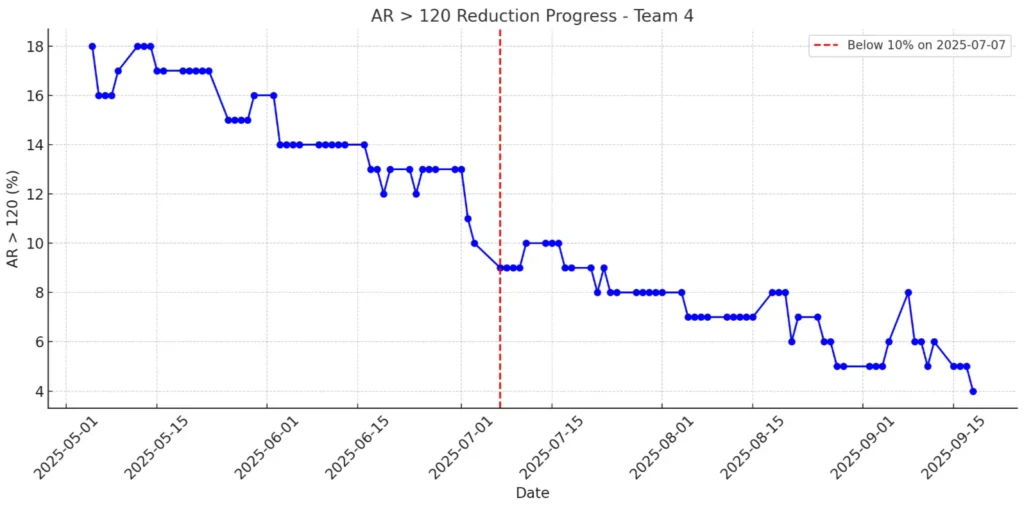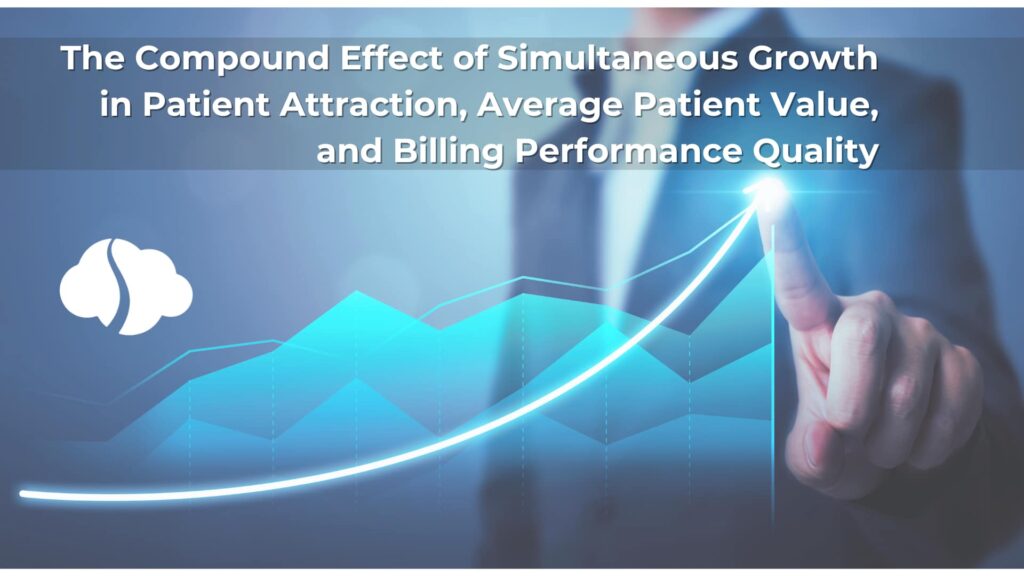How ClinicMind’s RCM Software + Service Reduced A/R Over 120 to 4%

How ClinicMind’s RCM Software + Service Reduced A/R Over 120 to 4% In healthcare revenue cycle management (RCM), results are what count. Achieving numbers like these is rare. ClinicMind’s RCM Team recently reached an A/R over 120 days of just 4%, which is only a third of the industry average of 13.4% according to MGMA. This milestone didn’t happen by chance. It came from ClinicMind’s approach of blending strong RCM software with skilled human support. This system helps practices lower their aged A/R and speed up cash flow. What is A/R > 120, and Why Does It Matter? Accounts Receivable (A/R) aged beyond 120 days represents money practices may never collect. The higher the percentage, the greater the financial strain. With the industry benchmark sitting at 13.4%, many practices face delayed or lost revenue. ClinicMind’s Team kept their rate at just 4%, showing that practices can reach and maintain top results when they have the right tools and expertise. From 13% to 4%: ClinicMind’s 60-Day A/R Reduction Journey Late June 2025 Team was at 13%, aligned with MGMA benchmarks. In July 2025, our numbers improved steadily, moving from 12% to 9%, then 7%, and finally 6%. By August 2025, we held steady between 5% and 7%, finishing the month at 4%. Within 60 days, we cut our aged A/R in half and kept it at that level. ClinicMind RCM Software: Automating Revenue Cycle Management Our software helps you work more accurately, saves time with automation, and keeps everything clear. Daily RCM Dashboards: The 4% metric itself came from real time ClinicMind dashboards, providing transparency for clients and teams alike. Automated Denial Alerts: Same-day appeal workflows were triggered instantly by software, preventing delays. Bulk Patient Statements: Automated statement generation and small balance sweeps ensured no revenue was overlooked. Account Prioritization: Smart filters highlighted high-balance accounts, allowing teams to focus on the most critical accounts first. Expert RCM Services that Deliver Results Same-Day Appeals: Analysts acted immediately on flagged denials. Collector Focus: Experienced team members handled the top 20 high-balance accounts directly. Backlog Blitz: Analysts were temporarily reassigned to address the A/R over 120-day backlog. They worked at scale based on insights from the dashboards. The Result: Software created visibility and automation; the service team applied judgment, persistence, and expertise. This balance of technology and expert support is what makes ClinicMind a leader in healthcare revenue cycle management and RCM billing services. Why ClinicMind’s A/R Performance Matters for Practices Benchmark Beating: 4% vs. 13.4% shows ClinicMind delivers world-class outcomes. Consistency: This was not just a brief improvement. The ongoing performance trend shows that these results are sustainable. Scalability: The same playbook of software + service can be replicated across other teams and client BPOs. By combining RCM software with expert human support, ClinicMind helps practices achieve world-class revenue cycle optimization Software + Service = Sustainable RCM Success Technology by itself can’t fix revenue cycle challenges, and service alone won’t scale without the right data and automation. ClinicMind’s story shows that when smart software and expert service work together, the financial results are hard to beat. See how your practice can achieve industry-leading A/R results with the right technology and expert support – Book a consultation to learn more
The Compound Effect of Simultaneous Growth in Patient Attraction, Average Patient Value, and Billing Performance Quality

In the world of healthcare practices, sustainable growth requires more than just delivering excellent care—it demands a strategic approach to increasing revenue and operational efficiency. To achieve consistent and scalable growth, practices can focus on improving three critical areas simultaneously: patient attraction, average patient value (APV), and billing performance quality. The synergistic effect of advancing these pillars creates a compounding impact that accelerates the practice’s success. 1. Patient Attraction: The Gateway to Growth Patient attraction is the foundation of a thriving healthcare practice. Without a steady influx of new patients, growth stagnates, and opportunities for increasing revenue diminish. Strategies for Improving Patient Attraction: Digital Presence: Build a robust online presence through a well-designed website, active social media engagement, and local search optimization. Reputation Management: Encourage satisfied patients to leave reviews and testimonials. Positive reviews build trust and attract new patients. Community Outreach: Partner with local businesses, schools, or organizations to raise awareness of your services. Specialized Services: Offer niche or advanced procedures that differentiate your practice from competitors. The more effectively you attract patients, the larger your pool for implementing improvements in the other two areas—APV and billing performance. 2. Average Patient Value: Maximizing the Patient Relationship Once patients are in the door, the focus shifts to increasing their lifetime value to the practice. APV measures the revenue each patient generates over time. By optimizing APV, practices ensure they’re making the most of every patient interaction. Strategies for Enhancing APV: Upselling and Cross-Selling: Educate patients about complementary or advanced treatment options that enhance their care experience and outcomes. Membership Programs: Offer subscription-based plans for routine services to encourage patient loyalty and consistent revenue streams. Continuity of Care: Implement systems to schedule follow-up visits, ensuring ongoing patient engagement and treatment adherence. Patient Education: Empower patients with knowledge about their conditions and available treatments, fostering trust and encouraging higher-value care decisions. Increasing APV not only boosts revenue but also strengthens patient relationships, creating ambassadors who promote your practice organically. 3. Billing Performance Quality: Ensuring Financial Efficiency Revenue cycle management (RCM) is often overlooked as a growth driver, but effective billing practices ensure that every dollar earned is collected promptly and accurately. Billing performance quality directly impacts cash flow and profitability. Strategies for Improving Billing Performance: Automation Tools: Invest in software that streamlines billing, reduces errors, and accelerates claim submissions. Training and Development: Regularly train staff on coding updates, insurance guidelines, and patient communication. Transparent Pricing: Offer clear, upfront pricing to minimize patient confusion and improve collections. Data Analysis: Monitor key performance indicators (KPIs) like denial rates, days in accounts receivable (AR), and collection rates to identify and address inefficiencies. A well-oiled billing system allows practices to reinvest resources into patient attraction and care enhancements, fueling further growth. The Compound Effect: How These Pillars Amplify Each Other When practices focus on all three areas simultaneously, the growth potential multiplies. Here’s how the compounding effect works: Enhanced Patient Experience: Improved APV strategies often include better communication, education, and follow-up care, which naturally attract more patients through word-of-mouth referrals. Increased Operational Capacity: Efficient billing improves cash flow, enabling investments in marketing and patient-centric technologies that further boost attraction and APV. Scalable Growth: A higher APV means more revenue per patient, reducing the pressure to attract massive numbers of new patients to achieve financial goals. By aligning efforts in these areas, practices create a self-reinforcing growth loop. New patients bring in revenue, efficient billing optimizes cash flow, and higher APV ensures each patient contributes more to the practice’s success. Final Thoughts: A Blueprint for Sustainable Growth To create compounding growth, practices must take a strategic, data-driven approach. Start by assessing your current performance in patient attraction, APV, and billing. Identify opportunities for improvement, set measurable goals, and invest in tools and training to support your team. When these pillars work together, the results are transformative. Not only will your practice grow, but it will also create a sustainable, patient-centric business model that thrives in any healthcare environment. By committing to continuous improvement, you can unlock the full potential of your practice and achieve lasting success.
Make Payments a Competitive Advantage for Your Practice

In the fast-evolving world of healthcare, efficiency is critical. From patient care to administrative tasks, every second counts. One area where practices often struggle is managing patient payments. Multiple systems, manual entry, and clunky payment processes create unnecessary bottlenecks for practices and headaches for patients. So, how can healthcare providers overcome these challenges? Introducing ClinicMindPay, our newly launched integrated payment processing solution that seamlessly integrates with ClinicMind’s EHR and practice management system. Designed to simplify the payment experience for both patients and practices, ClinicMindPay offers the flexibility, security, and convenience that healthcare practices need to thrive in today’s competitive landscape. Why Should Practices Use ClinicMindPay? If you manage a healthcare practice, you’re likely familiar with the challenges surrounding payment processing. Whether it’s dealing with delayed payments, reconciling invoices manually, or navigating multiple platforms, these inefficiencies add unnecessary complexity to your day-to-day operations. Payment management is often a time-consuming process that can take your focus away from patient care. That’s where ClinicMindPay comes in. Powered by Fortis’ proven technology, ClinicMindPay not only streamlines payments but also fully integrates with ClinicMind’s suite of solutions. Imagine never having to worry about missing payments or spending hours entering data. With ClinicMindPay, your payments sync effortlessly, giving you time back to focus on what matters most—your patients. How ClinicMindPay Solves Payment Challenges Complete Integration: One of the standout features of ClinicMindPay is its seamless integration into your existing ClinicMind EHR and practice management system. Payments are automatically recorded and tracked, reducing administrative workload and minimizing errors. Patient Convenience: In today’s digital world, patients expect convenience. ClinicMindPay allows your patients to pay using their preferred method—whether it’s a credit card, ACH, or even digital wallets—making it easier for them to settle their bills quickly and efficiently. Secure and Reliable: Security is paramount in healthcare, and ClinicMindPay is built with that in mind. Our platform offers top-notch security features to ensure that all transactions are processed safely, providing peace of mind for both you and your patients. Streamlined Reporting: With comprehensive reporting tools, ClinicMindPay makes it easy to track payments, generate reports, and gain insights into your revenue cycle. The result? A more organized, efficient, and financially healthy practice. The Transition for Fortis Clients For our valued Fortis users, the transition to ClinicMindPay is effortless. You won’t need to do anything—your account will be automatically migrated to ClinicMindPay, and you’ll continue to enjoy the same reliable payment services, now with deeper integration into ClinicMind’s suite of solutions. Why Choose ClinicMindPay? ClinicMindPay reflects our dedication to delivering a seamless, all-in-one solution for managing payments. More than just a payment platform, it’s an integrated tool crafted to streamline your operations, enhance patient satisfaction, and boost overall efficiency in your practice. If you’re ready to simplify your payment processes and enhance your practice’s financial health, ClinicMindPay is the solution you’ve been waiting for. For more information on ClinicMindPay and how it can benefit your practice, visit our ClinicMindPay page. You can also check out our full press release to dive deeper into how ClinicMindPay is transforming payment solutions for healthcare providers. Read the press release here.
Transforming Healthcare Billing: How ClinicMind’s Billing Depot Addresses Current Challenges

In today’s fast-paced healthcare landscape, the need for efficient and secure billing solutions has never been more critical. Recent events, such as the cyberattack on UnitedHealth Group, have highlighted vulnerabilities in the healthcare sector, raising questions about data security and the integrity of billing practices. As healthcare providers navigate these challenges, ClinicMind’s Billing Depot emerges as a vital tool in modern practice management. Understanding the Current Landscape The UnitedHealth Group cyberattack serves as a wake-up call for healthcare organizations, reminding them of the importance of robust cybersecurity measures. With sensitive patient data at risk, healthcare providers must prioritize security without sacrificing efficiency. Billing systems are often prime targets for cybercriminals, making it essential for practices to adopt solutions that not only streamline billing processes but also safeguard sensitive information. Why Choose Billing Depot? ClinicMind’s Billing Depot offers a comprehensive billing management solution tailored to the needs of healthcare providers. Here are several key features that set Billing Depot apart, especially in light of current events: Enhanced Security Protocols: ClinicMind’s Billing Depot employs state-of-the-art security measures to protect patient data. This includes encryption, secure access controls, and regular audits to ensure compliance with industry standards. In a time when cyber threats are prevalent, these features provide peace of mind for both providers and patients. Streamlined Workflow: The software simplifies the billing process, reducing administrative burdens. By automating tasks like claim submissions and payment tracking, ClinicMind’s Billing Depot allows healthcare professionals to focus on patient care rather than paperwork. This efficiency is particularly important as practices adapt to increasing patient loads and changing regulations. Real-Time Analytics: With integrated analytics tools, ClinicMind’s Billing Depot empowers practices to make informed financial decisions. Providers can track revenue cycles, identify trends, and optimize their billing strategies. This data-driven approach is crucial for navigating the financial uncertainties posed by ongoing healthcare challenges. Patient-Centric Approach: ClinicMind’s Billing Depot enhances patient engagement through transparent billing processes. Clear communication regarding charges and payments fosters trust, which is essential in a time when patients are more conscious of healthcare costs. Scalability: As healthcare practices grow or adapt to new challenges, ClinicMind’s Billing Depot scales to meet evolving needs. This flexibility is particularly valuable for organizations responding to shifting regulations and market demands. Staying Ahead of Industry Trends The healthcare industry is continually evolving, influenced by technological advancements and regulatory changes. As practices seek to stay competitive, tools like ClinicMind’s Billing Depot can make a significant difference. By integrating advanced billing solutions, providers can not only enhance operational efficiency but also strengthen their resilience against potential cyber threats. In conclusion, ClinicMind’s Billing Depot is not just a software solution; it’s a partner in navigating the complexities of healthcare billing in a rapidly changing environment. As the industry faces challenges like cyberattacks and financial pressures, embracing innovative technology can lead to improved outcomes for both providers and patients. Ready to transform your practice’s billing process? Discover how ClinicMind’s Billing Depot can enhance your efficiency, security, and patient satisfaction. Book a Demo Now! https://clinicmind.com/billing-depot-billing-practice-management-page/

